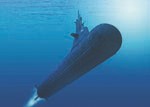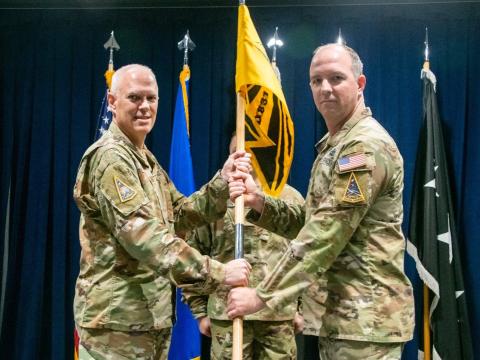Change at the Roots Defines Swedish Military
 |
A Swedish air force JAS-39 Gripen taxis on a neighborhood road during a dispersed operation. The multirole fighter, which is designed to operate from local streets and highways in wartime, is being upgraded with new avionics and other electronic systems as part of a steady military modernization that is taking place amid a significant Swedish force transformation. |
Sweden is transforming its military across the board, beginning with its personnel makeup. The Northern European country, which has not been at war since 1814, is transitioning from a conscript military to a fully professional force. This change will reshape the military along different force lines with different emphases.
At a time when many other Western militaries are looking at deep cuts in their defense budgets, Sweden expects at worst a flat budget for the foreseeable future. Priorities for hardware expenditures may shift depending on ongoing studies, but not because of budget pressures.
As with all modern militaries, technology will continue to play a significant role in empowering Swedish forces. But, unlike other militaries that are drenching their forces in the newest information technologies, Sweden is adopting a targeted approach that maximizes cost efficiencies while addressing the changes taking place throughout its military.
Yet the single greatest change affecting the Swedish military is its transformation from a conscript force to a professional volunteer force. This effort is not merely changing the types of people who will staff the military; it also is affecting the shape, size and function of individual units.
Håkan Jevrell, state secretary for defense, describes the transformation to an all-volunteer force as the biggest challenge facing Sweden’s military. With the traditional conscription-based force, many units existed only on paper, he charges. Sweden relied heavily on reserves that would be called up in times of war, but some experts calculated that it would take up to one to three years for some units to achieve readiness.
Jevrell estimates that these traditional units would have been ready for action only one month out of an entire year. Shortly thereafter, the fully trained conscripts would leave the military, which then would need to start over with new conscripts requiring basic training.
The new all-volunteer force would be agile with high flexibility and readiness. Every unit would be fully manned and equipped, so that in the event of an emergency, these units would be ready for operations in a matter of days. So far, Jevrell says, the implementation has gone well, with recruitment a success. Next autumn, the government will propose terms for part-time soldiers and airmen.
Gen. Sverker Goranson, SWA, supreme commander of the Swedish armed forces, offers that short-term indications for the professional force are good. The groups the military has targeted for recruitment are showing great interest, he states. He does add that it is too early in the transition to offer long-term predictions about the success of the transformation.
The transformation also will help the Swedish military carry out a key noncombat mission—domestic disaster response. When the professional force is completed, it will have personnel available for operations around the clock.
While Sweden’s military priorities are changing, its total spending should remain stable. The global financial crisis has not affected Sweden’s military as much as it has other Western forces, many of which are facing draconian defense reductions. The Swedish defense budget is not being cut. However, neither should the force expect increased spending. Both Gen. Goranson and Jevrell predict a flat budget for the foreseeable future—at least through 2014.
While overall military funding will not decline, spending priorities will shift. The personnel transformation will require adequate funding to succeed by the target date of 2014, Jevrell states. Some of this funding will need to come from a separate effort aimed at streamlining support structures. An ongoing government study is focusing specifically on that issue.
The military also will reduce spending on some leading-edge technology development projects. Sweden’s new approach will focus on providing better value with shorter lead times. This entails buying proven off-the-shelf products that are in use with other allied nations.
Gen. Goranson lists five technology areas that are top priorities for Swedish defense. High on the list are technologies for countering improvised explosive devices (IEDs). With Sweden increasingly taking part in overseas peacekeeping operations, including ongoing efforts in Afghanistan, countering IEDs is a key to securing its forces beyond its borders.
Another priority area is submarine technology. Sweden plans to replace its older Södermanland-class submarines with at least two new vessels developed by its domestic firm Kockums. As with the navy’s newer diesel-electric Gotland-class submarines, the future submarines, designated A26, would be powered by a Stirling air-independent propulsion system. Sweden is looking to take delivery of these two A26 submarines before the end of the decade, and it also plans to upgrade two of its three Gotland boats in the same time frame.
The backbone of Sweden’s air force, the JAS-39 Gripen, also will be upgraded. This technology priority aims at improving the aircraft’s electronic capabilities, both in terms of internal avionics and in command, control and communications.
 |
This artist’s concept shows a Swedish A26 submarine on blue water patrol. Sweden hopes to introduce the advanced vessel by the end of the decade. |
The fifth priority is to miniaturize equipment. Many types of technologies—in addition to electronic circuitry—now can be manufactured in smaller sizes. This applies to components as well as entire systems. By reducing the size of many existing systems and retrofitting them on existing platforms, the military may see extended range, reduced power consumption and improved performance in its gear.
Even though Sweden is reducing spending on some leading-edge technology development projects, Jevrell notes that Sweden is not abandoning research and development. It simply does not need to spend money on every research area. Unlike during the Cold War, the country now is configuring a defense structure and a security policy that depends on building security with others, and that approach is being applied to defense procurement.
Gen. Goranson describes the perspective for overall defense industrial policy as “here and now.” He sees a need for more long-term planning, including for research and development. The planning perspective could be both national and international in scope, especially with regard to Europe, he adds.
Originally designed for home defense exclusively, Sweden’s military now is active internationally in coalition operations. Sweden has contributed to European Union (EU) operations in Africa, and it is leading an EU battle group in the first half of this year. Other units currently are involved in the Balkans and in Afghanistan, and the country plans to increase Sweden’s capability for international peace support operations. The goal is to double the capacity, Jevrell says. Sweden is not changing its military as much as it is taking advantage of its ability to conduct operations outside its borders, which is necessary for is own homeland defense.
“There is truly a clear commitment to take part in future peacekeeping operations,” Jevrell declares. “When [the transformation into a volunteer force] is fully done, we will have a good capability of actually doing this without having to wait many months to have troops ready to deploy.”
With Sweden taking on more international operations, interoperability with other forces in coalitions is a major challenge. Jevrell allows that Sweden has been working hard to improve its interoperability since the mid-1990s, when it joined the Partnership for Peace. The military has made great progress, he says, as forces are using NATO terminology and methods. Sweden’s communications gear is being adapted, and the newest version of the Gripen fighter aircraft now is fully NATO-compatible.
Gen. Goranson offers that Sweden’s military interoperates very well with forces of other countries. However, he cites the need for improved interoperability in tactics, techniques and procedures. And, full command, control and communications interoperability remains elusive. The general notes that Sweden does not have all of the different pieces of equipment that NATO nations possess.
Sweden continues to work with its Nordic neighbors on finding new areas of cooperation, particularly for improving efficiency in areas such as joint procurement, training and maintenance. Sweden is considering sharing training programs with other Nordic and Baltic countries. Sweden also has been launching a similar initiative on the European level, Jevrell reports.
However, the fact that Sweden is not a NATO member has been a bit of a hurdle to the country’s interoperability efforts. NATO’s cooperation with Sweden has been excellent, Jevrell offers; but, echoing Gen. Goranson’s remarks, he notes that Sweden still does not have the same interoperability opportunities that are available to NATO’s full members. Resolving European airspace issues for air controllers, for example, would help spur interoperability work.
Jevrell notes that not all aspects of a force can be interoperable. “Every nation has a right to have certain specialties to maintain security, and that has to be addressed in a proper and wise way,” he declares.
In 10 years, the Swedish military will be transformed into a better force, Jevrell states. It will feature a slimmer and better support structure equipped with a new generation of submarines, new medium-lift helicopters and fully operational new corvettes.
Other changes may lie in store. Sweden is looking at greater use of unmanned aerial vehicles, and their implementation could impel radical changes throughout the entire armed forces.
Gen. Goranson predicts that the future Swedish military will be “more expeditionary, more flexible and available with developed skills in a comprehensive approach.” Interoperability will be improved, as will the capacity for greater civil-military cooperation.
He compares the Swedish military transformation to that of U.S. forces. The general served as an attaché in the United States before, during and after the September 11, 2001, terrorist attacks, and he witnessed firsthand the U.S. Army’s transformation into a more flexible, brigade-centric force. Gen. Goranson states that Sweden is adopting some of that concept to create a more expeditionary force that is ready to respond to modern threats as they emerge.
“The nature of today’s and tomorrow’s threats is very often without borders, to which we need to adapt,” the general declares.
WEB RESOURCES
Swedish Armed Forces (English): www.forsvarsmakten.se/en
Swedish Ministry of Defense (English): www.sweden.gov.se/sb/d/2060




Comments